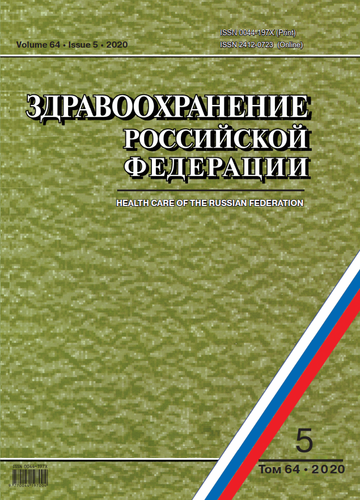Improvement of institutions for dispensary observation of children from the risk group in phthisiology
- Authors: Sharapova O.V.1, Brynza N.S.2, Kicha D.I.3, Gerasimova L.I.1, Slashcheva D.M.2, Pirogova N.D.4, Petrushina A.D.2
-
Affiliations:
- Vinogradov V.V. Municipal clinical hospital
- Tyumen State Medical University
- Peoples’ Friendship University of Russia, RUDN University
- Regional Clinical TB Dispensary
- Issue: Vol 64, No 5 (2020)
- Pages: 264-270
- Section: PROBLEMS OF SOCIALLY SIGNIFICANT DISEASES
- Submitted: 25.10.2024
- URL: https://rjonco.com/0044-197X/article/view/637941
- DOI: https://doi.org/10.46563/0044-197X-2020-64-5-264-270
- ID: 637941
Cite item
Full Text
Abstract
Introduction. Tuberculosis in Russia is one of the primary problems of epidemiology and public health.
The purpose: to analyze the epidemic situation of tuberculosis in high-risk groups of children and adolescents in the Tyumen region of Russia.
Material and methods. Were analyzed the annual reporting forms No. 33 «Information about patients with tuberculosis» for 2014-2018 in the Tyumen region.
Results. According to our research, research materials in the region, WHO recommendations for eliminating tuberculosis by 2035 the need to develop new approaches and practical recommendations for clinical dispensary observation of children with altered tuberculin sensitivity is justified.
Discussion. The epidemic situation among children with altered tuberculin sensitivity by 2018 in the districts of the Tyumen region is characterizing by its heterogeneity. In some districts of the region, the number of children with a turn of tuberculin reactions remains high or continues to increase. Such trends can be associated with the incidence of tuberculosis and the presence of patients with open forms of respiratory tuberculosis in these areas.
Conclusion. To improve the efficiency of preventing the development of active tuberculosis in Russian children in 2010, a mathematical model of immune response developed in the Tyumen Region based on the study of immunological indices in groups of children with high sensitivity and hyperresponsiveness to the Mantoux tests 2TE samples. The model can be successfully used for diagnostics and assess the characteristics of the course of tuberculosis infection.
About the authors
Olga V. Sharapova
Vinogradov V.V. Municipal clinical hospital
Author for correspondence.
Email: noemail@neicon.ru
ORCID iD: 0000-0003-0384-1705
Russian Federation
Natalya S. Brynza
Tyumen State Medical University
Email: noemail@neicon.ru
ORCID iD: 0000-0001-5985-1780
Russian Federation
Dmitry I. Kicha
Peoples’ Friendship University of Russia, RUDN University
Email: noemail@neicon.ru
ORCID iD: 0000-0001-6529-372X
Russian Federation
Lyudmila I. Gerasimova
Vinogradov V.V. Municipal clinical hospital
Email: profgera@mail.ru
ORCID iD: 0000-0002-3976-0934
MD, Ph.D., DSci., head of the educational and methodological office of the V.V. Vinogradov Municipal clinical hospital, Moscow, 117292, Russia.
e-mail: profgera@mail.ru
Russian FederationDaria M. Slashcheva
Tyumen State Medical University
Email: noemail@neicon.ru
ORCID iD: 0000-0002-9975-5635
Russian Federation
Natalia D. Pirogova
Regional Clinical TB Dispensary
Email: noemail@neicon.ru
ORCID iD: 0000-0002-8415-9961
Russian Federation
Antonina D. Petrushina
Tyumen State Medical University
Email: noemail@neicon.ru
ORCID iD: 0000-0003-1567-3710
Russian Federation
References
- Aksenova V.A., Sevost’yanova T.A. Tuberculosis in children and teenagers in Russia. Lechashchiy vrach. 2013; (1): 35–9. (in Russian)
- Order of the Ministry of Health of Russia № 109. On improving anti-tuberculosis measures in the Russian Federation. Moscow; 2003. (in Russian)
- News bulletin. Epidemiological indicators for tuberculosis and the results of the activities of the phthisiology service of the Tyumen region for 2013-2014, 2014-2015, 2015-2016, 2016-2017, 2016-2017. Available at: https://obltub.ru/about/oficialnaya-informaciya/otchety-i-itogi/informacionnyj-byulleten.html (in Russian)
- Slashcheva D.M., Brynza N.S. Analysis of the main indicies for tuberculosis in the Tyumen region for 2013-2017. Universitetskaya meditsina Urala. 2019; 5(1): 119–21. (in Russian)
- Tyul’kova T.E. Improving the diagnosis and prevention of tuberculosis infection in older children and adolescents: Diss. Moscow; 2010. (in Russian)
- Arnadottir T. Tuberculosis: trends and the twenty-first century. Scand. J. Infect. Dis. 2001; 33(8): 563–7. https://doi.org/10.1080/00365540110026836
- Rennie T.W., Bothamley G.H., Engova D., Bates I.P. Patient choice promotes adherence in preventive treatment for latent tuberculosis. Eur. Respir. J. 2007; 30(4): 728–35. https://doi.org/10.1183/09031936.00034007
- Starke J.R. Tuberculosis in children: where do we go now? Pediatr. Pulmonol. Suppl. 1999; 18: 140.
- Ellner J.J. Immunosuppression in tuberculosis. Infect. Agents Dis. 1996; 5(2): 62–72.
- Lagrange P.H., Wargnier A., Herrmann S.J. The immune responses in tuberculosis: Role for pathogenesis, diagnosis and prevention. Pediatr. Pulmonol. 1999; 18: 136-9.
- WHO/HTM/TB/2015.31. Implementing the End TB strategy: The Essentials. Geneva; 2015.
Supplementary files










